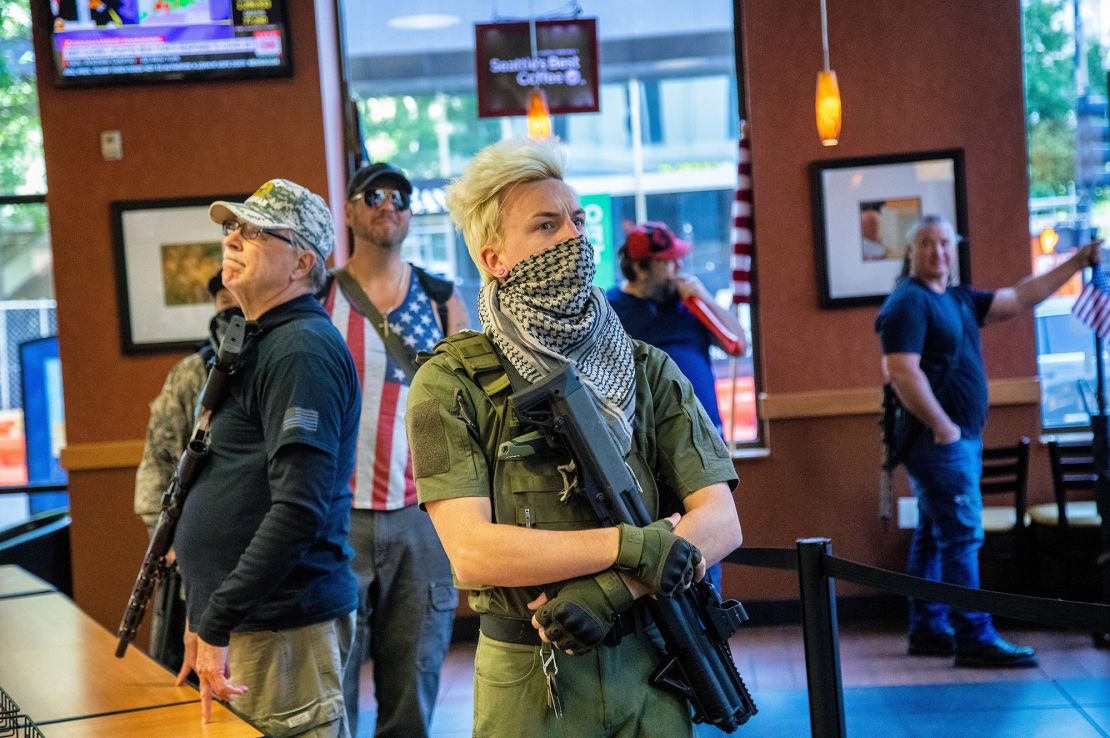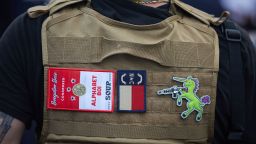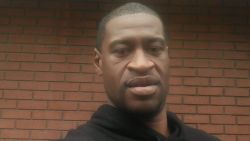Benjamin Ryan Teeter was at his home in Hampstead, N.C., when the call to action came. It was an alert from the heart of the raging protests in Minneapolis, posted on an online forum by a fellow member of the Boogaloo movement, a loosely knit group of heavily armed, anti-government extremists.
The “alert” was from a man who had a run-in with the Minneapolis police while on the frontline of the police-brutality protests set off by the death of George Floyd.
“He caught mace to the face,” said Teeter, and “put out a national notice to our network.”

After Teeter – who goes by Ryan – said he saw the online posting, he and a handful of other Boogaloo friends in the area mobilized.
They grabbed their guns – mostly assault rifles – hopped into their vehicles, and made the 18-hour trek to Minneapolis.
The Boogaloos are an emerging incarnation of extremism that seems to defy easy categorization. They are yet another confounding factor in the ongoing effort among local, state and federal officials to puzzle out the political sympathies of the agitators showing up to the mostly peaceful George Floyd rallies who have destroyed property, looted businesses, or – in the case of the Boogaloos who descended on Minneapolis – walked around the streets with assault rifles.
Boogaloo members appear to hold conflicting ideological views with some identifying as anarchists and others rejecting formal titles. Some pockets of the group have espoused white supremacy while others reject it. But they have at least two things in common: an affinity for toting around guns in public and a “boogaloo” rallying cry, which is commonly viewed as code for another US civil war.
Megan Squire, a computer science professor at Elon University in North Carolina who monitors online extremism, said the movement started in obscure online platforms.
It “is now growing on mainstream platforms, and in this moment of protest it is starting to move offline,” she said. “It resembles the militia movement that came before it, which has been well documented as a force for promoting violence.”
Teeter, in an interview with CNN, said he identifies as an anarchist. His mission in Minneapolis, he said, was to protect protesters from police abuse and white supremacists, whom he deplores.
“If people are going to initiate deadly force against us, we need to be willing and able to initiate deadly force in return,” Teeter, 22, said.
Despite the presence of Teeter, and he said a dozen or so of his compatriots, federal, state and local officials have put forth little evidence so far to suggest widespread organization and mobilization by any one ideological group. A CNN review of the backgrounds of those arrested during the first three days of protests in Minneapolis did not surface any obvious links to known organizations.
Some police said they suspect that much of the rioting and looting was perpetrated not by ideological extremists, but smaller groups of criminal opportunists seeking to profit by stealing merchandise.
“These are straight up criminals. These are not protestors,” said one high-ranking LAPD official. In Los Angeles, he said, roving bands of thieves drove around in cars and communicated by cellphone, identifying businesses to loot.
Still, there are some documented reports of group-affiliated individuals from the left and right of the extremist spectrum mingling amid the less organized.
In Nevada, federal prosecutors this week charged three men who allegedly identify with the Boogaloo movement with possessing a “Molotov cocktail” explosive and conspiring to “cause destruction during protests in Las Vegas,” according to a press release from the US Attorney’s Office.

Stephen T. “Kiwi” Parshall, Andrew Lynam, and William L. Loomis, all of whom have military experience, had attended a protest on May 29 honoring George Floyd in Las Vegas, according to the criminal complaint. Parshall allegedly tried to encourage violence by “telling protesters that peaceful protests don’t accomplish anything,” the complaint states. The three men were arrested on their way to a second Floyd-related demonstration the following day, allegedly armed with a Molotov cocktail, according to the records.
Gun-toting Boogaloo members also have appeared at George Floyd protests in Minneapolis, Salt Lake City, Dallas, Atlanta and elsewhere, according to The Washington Post.
Known for sporting Hawaiian shirts and arriving to public protests heavily armed, the decentralized Boogaloo movement – sometimes referred to as the “Boogaloo Bois” – is often associated with the far-right.
But it is far from a cohesive group, said J.J. MacNab, a fellow at George Washington University who studies anti-government extremism.
“While there are pockets of white supremacist Boogaloos, the younger and bigger groups are generally not,” she said in a recent Twitter thread. “While there are Boogaloos that support police, the younger and bigger groups detest them. While there are Boogaloos that want to discredit protests angry at the murder of a black man, there are younger Boogaloos that are incensed by the murder and want to join the protests.”
MacNab added that such internal divisions don’t always play out according to age.
“They share jargon, outfits, a love of firearms, and a desire to use violence to gain power, but they don’t actually share a common goal once power is achieved,” she said.
The origin of the name is thought to trace back to a 1980s movie sequel about breakdancing called “Breakin’ 2: Electric Boogaloo.” The term “boogaloo” in recent years has caught on as a sly online reference to social unrest and a desired second civil war.
“The boogaloo meme” is a “joke for some,” but “acts as a violent meme that circulates instructions for a violent, viral insurgency for others,” says a white paper released in February by the Network Contagion Research Institute, a group of independent researchers who monitor misinformation and hate speech, in association with Rutgers University.
“Termed the ‘boogaloo,’ this ideology self-organizes across social media communities, boasts tens of thousands of users, exhibits a complex division of labor,” says the report, and “evolves well-developed channels to innovate and distribute violent propaganda.”
There are signs that adherents have been venturing out of the chat rooms and into the real world, most notably at various reopen demonstrations during the Covid-19 lockdowns. In April, a Boogaloo devotee was arrested in Texas for allegedly attempting to find and kill police officers while filming on Facebook Live, according to the Southern Poverty Law Center.
The movement seems to have gained considerable traction in recent months.
The Tech Transparency Project of a non-profit watchdog group called Campaign for Accountability released a report this spring concluding that more than 60% of the 125 identifiable Boogaloo groups on Facebook have sprung up since January, and picked up steam after the onset of the Covid-19 lockdowns.
To talk to Teeter – who also recently attended protests decrying the Covid-19 lockdown – is to get a sense of just how profoundly scrambled the Boogaloo ideology can be.
“I’m a member of the LGBT community,” said Teeter, who describes himself as a non-voting “left anarchist…People think I’m part of a Nazi group; I’m not.”
But, he added, “I don’t think people should be forced to bake the cake,” referring to a US Supreme Court case that stemmed from the refusal of a Christian owner of a bakery in Colorado to provide a wedding cake for a gay couple.
In Minneapolis, Teeter said, he and others in his group stood sentry with firearms outside of mom-and-pop shops, but in solidarity with the black community in opposition to police brutality.
“We are very careful to make sure that people realize that we are on their side. We are here to defend them … Once people realize that we are on their side and we are here to protect them, everybody has been – almost everybody – has been very happy to have us here.”
Teeter said he was home schooled, but did not complete college despite being offered scholarships.
“I’ve always been able to self-educate,” he said. “We have the Internet. You can learn anything you want to learn for free.”
He has had some brushes with the law. He said on a recent podcast that he’s been to jail “eight or nine” times, though he suggested at least some of those incidents involved actions related to his activism.
An administrator for the New Hanover County criminal court in North Carolina told CNN that Teeter has a pending charge from January of 2019 for discharging a firearm in city limits. Teeter told CNN it was an accidental discharge that occurred while he was cleaning the weapon.
His social media posts appear consistent with his idiosyncratic political persuasions: photos of himself in a flak jacket or participating in the reopen protests, and memes lamenting police brutality, celebrating black men with guns, ridiculing both President Trump and Democratic Presidential candidate Joe Biden, and glorifying the Boogaloo movement and the notion of “coming civil conflict.”
Extremism experts say other militias are starting to adopt the Boogaloo moniker.
A report on the “Militia-sphere” released Tuesday by the Network Contagion Research Institute said militias such as Oath Keepers and Three Percenters “now share the same boogaloo meme both in the virtual and real world.”
Squire said there appears to be a generational divide in the Boogaloo movement, with the younger subset having been steeped in meme culture online, and the older group looking for a rebrand.
“It’s like an updated, younger take,” she said. “And so that’s appealing to the guys who are in the actual meme-ing, very online age group, right. But it’s also appealing to these older guys, who are kind of stale.”
Squire, who tracks the online chatter of groups such as Boogaloo, alerted CNN about Teeter’s trip to Minneapolis. She said he is emblematic of the younger subset. But according to the social media data she monitors, Squire said Teeter stands out for having taken the initiative to drive all the way to Minneapolis.
“We’ve seen less of that – driving across the country – because the protests have erupted in more places,” she said. “And so these guys that were on the fence about whether or not to go, they can just stay where they are and just do the local protest.”
Teeter, by contrast, is proactive, Squire said.
“He’s committed,” she said. “He’s a vanguard.”
On the streets of Minneapolis, Teeter said his group hasn’t always been “kitted out” with guns drawn. During the day, when the protests have been more peaceful, Teeter said, he and his ilk have blended in with the crowds, chanting along.
He said they often bring out their weapons later in the day and into the evening, “once things start to get dark.”
CNN’s Scott Bronstein, Scott Glover and Collette Richards contributed to this report

























